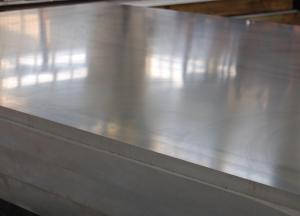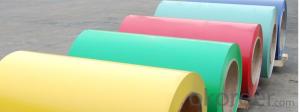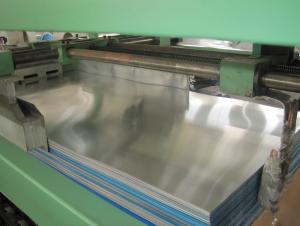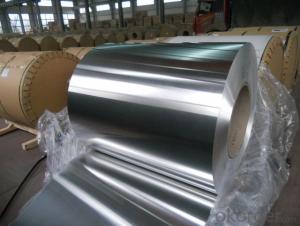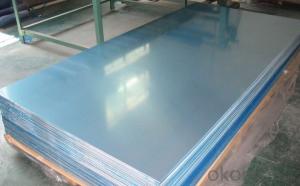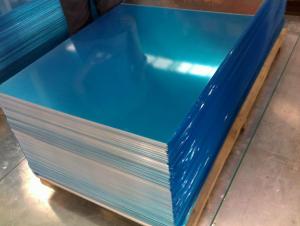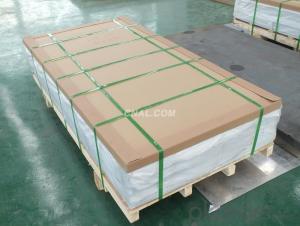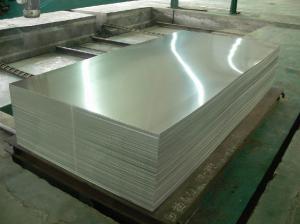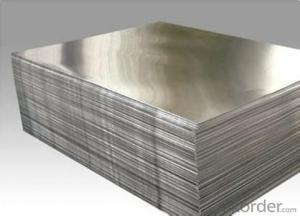Aluminum Perforated Metal Sheets with Mill Finished Surface AA3XXX
- Loading Port:
- China Main Port
- Payment Terms:
- TT or LC
- Min Order Qty:
- 5 Tons m.t.
- Supply Capability:
- 10000 Tons Per Month m.t./month
OKorder Service Pledge
OKorder Financial Service
You Might Also Like
1.Structure of Aluminum Sheets with Mill Finished Surface AA3XXX
Aluminum Sheets with Mill Finished Surface AA3XXX are strengthened and cut from raw materials with different alloys, such as AA3003, AA3105, etc.
Aluminum Sheets with Mill Finished Surface AA3XXX are light, easy for processing in different shapes, good in intensity and can be quickly installed.
Aluminum Sheets with Mill Finished Surface AA3XXX are widely used in curtain walls, roofing, decoration, boats, airframes, instrument panels, etc.
2.Main Features of Aluminum Sheets with Mill Finished Surface AA3XXX
•High intensity
•Easy to be processed and shaped
•Weather resistance
•Anti-pollution & environment protection
3.Aluminum Sheets with Mill Finished Surface AA3XXX Images
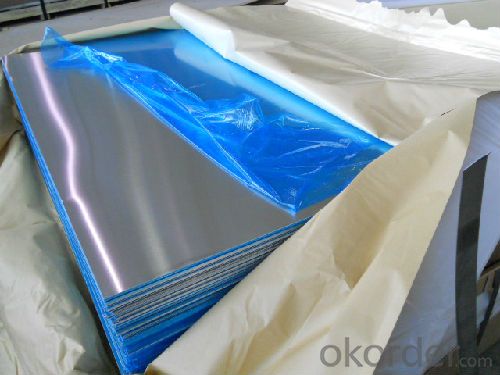
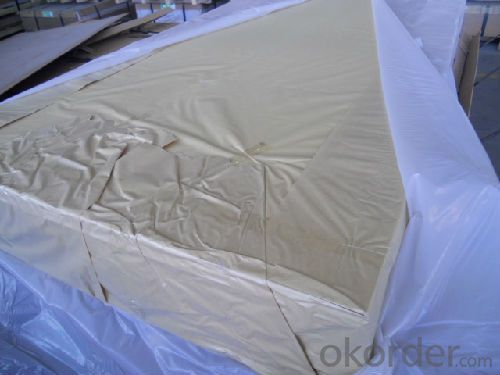
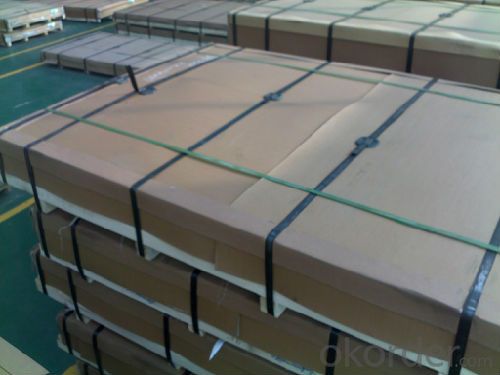
4.Specification of Aluminum Sheets with Mill Finished Surface AA3XXX
Alloy Number | AA3XXX |
Temper | H12, H14, H16, H18, H22, H24, H26, H32, HO, F |
Thickness | 0.1mm – 500mm |
Width | 10mm- 2200mm |
Standard | GB/T3880-2006, ASTM, ISO, EU standard |
5.FAQ of Aluminum Sheets with Mill Finished Surface AA3XXX
A.What about inspections to guarantee quality?
For each order for Aluminum Sheets with Mill Finished Surface AA3XXX, we will arrange strict inspection for raw materials, inspection during production and inspection for finished goods.
With requirement of customers, we also can arrange the third party inspection.
B.What about delivery?
We will put order for Aluminum Sheets with Mill Finished Surface AA3XXX in production schedule after order gets confirmed against copy of TT or L/C. Normally it takes about one month for production. Exact shipment schedule is different based on different sizes and quantity.
C.What is the MOQ?
5 tons for each size.
D. Where have you exported aluminium sheets?
We have exported aluminum sheets to many countries. Main markets include South East Asia, Middle East, North America, South America, etc.
- Q: Normally, when I install a 30-amp dryer receptacle, the wire is #10 copper and I double over the end with lineman's pliers prior to landing it in the lug just to be extra tight. Today I replaced a dryer outlet wired with #8 aluminum SE. The quandaray I have is that the lugs seem made for #6 and the #8 just sort of flattens and divides under the screw. Is this safe? The doubling over move makes the wire way too thick for the lugs to close. I've been doing electric for many years and have never run into this. Should I go back and re-run the circuit (only about 30 feet) in #10 copper? What is the actual draw of a typical electric dryer on high heat, anyway? Thanks.
- Make sure all work is done to code, we had a house with aluminum wiring, it gets hot when a larger load is applied. When selling, the couple who bought it had an inspector come and he said we had to do all this work or they could not get a mortgage. Whatever you do, make sure it is fully up to code, or you will have alot of trouble selling your home one day.
- Q: Are 101 aluminum sheets suitable for chemical storage tanks?
- 101 aluminum sheets are not appropriate for chemical storage tanks. Aluminum, particularly 101 aluminum, lacks resistance against numerous chemicals, which may cause corrosion and potential leakage. To withstand the corrosive properties of chemicals, chemical storage tanks necessitate materials specifically engineered for this purpose, such as stainless steel or certain types of plastics. It is crucial to employ chemically resistant materials that guarantee the safety and integrity of the chemicals being stored.
- Q: What are the different types of finishes available for aluminum sheets?
- Aluminum sheets come in several different finishes that are commonly used. These finishes serve to improve the appearance, protect against corrosion, and enhance durability. A prevalent finish is the mill finish, which is achieved naturally after the aluminum has gone through extrusion or rolling. While it has a smooth and shiny appearance, it is not as resistant to corrosion as other finishes. Another finish is the brushed finish, achieved by brushing the surface with a fine abrasive material. This creates fine lines on the surface, giving it a unique and textured appearance. Brushed finishes are commonly used in architecture and can also help conceal scratches and imperfections. Anodizing is a popular finish that involves immersing the aluminum in an electrolytic bath and applying an electric current. This forms a layer of aluminum oxide on the surface, providing excellent corrosion resistance and the ability to be dyed in various colors. Powder coating is another commonly used finish. It involves spraying a dry powder onto the aluminum surface and heating it to form a durable coating. Powder coating offers a wide range of colors and finishes, including matte, glossy, and textured. Lastly, there is the painted finish, which involves applying a liquid paint to the aluminum surface. This finish allows for high customization with virtually any color, pattern, or texture. The choice of finish for aluminum sheets depends on specific requirements such as aesthetics, corrosion resistance, and durability. Each finish offers unique advantages and can greatly enhance the appearance and performance of aluminum sheets.
- Q: Can aluminum sheets be bent or formed without cracking or breaking?
- Yes, aluminum sheets can be bent or formed without cracking or breaking, but it depends on the thickness of the sheet and the method used for bending or forming. Aluminum is a highly malleable metal, which means it can be easily bent or formed into various shapes without breaking. However, if the sheet is too thin or the bending or forming process is done without proper care or precision, there is a risk of cracking or breaking. To avoid this, it is important to use appropriate tools and techniques, such as using a bending brake or a rolling machine, and ensuring that the sheet is not subjected to excessive force or stress during the process. Additionally, annealing the aluminum sheet before bending or forming can increase its flexibility and reduce the chance of cracking. Overall, with the right approach and precautions, aluminum sheets can be successfully bent or formed without cracking or breaking.
- Q: Are 101 aluminum sheets suitable for conductive heat transfer applications?
- No, 101 aluminum sheets are not suitable for conductive heat transfer applications. 101 aluminum is a commercially pure aluminum alloy that has low electrical conductivity. It is not able to efficiently conduct heat, making it unsuitable for applications where heat transfer is desired. For conductive heat transfer applications, it is better to use alloys that have higher thermal conductivity, such as 6061 or 7075 aluminum. These alloys have better heat transfer properties and are commonly used in heat sinks, heat exchangers, and other applications where efficient heat transfer is required.
- Q: What are the different methods of polishing aluminum sheets?
- Polishing aluminum sheets can be done through various methods, each with its own pros and cons. Here are some commonly used techniques: 1. Manual polishing: By employing sandpaper or abrasive pads, one can manually rub the surface of the aluminum sheet to achieve a high level of shine and smoothness. However, this method demands physical effort and can be time-consuming, especially for larger sheets. Careful execution is crucial to avoid leaving behind scratches or marks. 2. Chemical polishing: Dissolving a thin layer of the aluminum surface using chemical compounds can result in a smoother and shinier finish. This method is suitable for larger sheets or complex shapes where manual polishing is impractical. However, chemical handling must be meticulous, and it may not be suitable for certain aluminum alloys. 3. Electropolishing: An electrochemical process involving the use of an electric current to remove a thin layer of material from the aluminum surface. This method guarantees a smooth and shiny finish for both small and large sheets. It is particularly effective in eliminating surface imperfections and achieving a uniform appearance. However, specialized equipment and expertise are required to properly control the process. 4. Vibratory finishing: Placing aluminum sheets in a vibratory machine with abrasive media, like ceramic or plastic chips, can help remove surface imperfections and achieve a polished finish. This method is ideal for large batches of sheets and can be cost-effective. Nevertheless, it may not produce the same level of shine as other methods. 5. Buffing and polishing compounds: These compounds are applied to the aluminum sheets and then buffed using a rotary tool or polishing machine. The abrasive particles in the compounds aid in removing scratches and enhancing the metal's shine. This method is relatively quick and easy, but it may not be as effective for significant oxidation or deep scratches. Ultimately, the choice of polishing method depends on factors such as the size and type of the aluminum sheets, desired level of shine, and available equipment and expertise. It is advisable to test different methods on a small area before proceeding with the full polishing process to ensure satisfactory results.
- Q: What are the different types of aluminum sheets available?
- There are several different types of aluminum sheets available, each with their own unique properties and uses. Some of the most common types include: 1. Pure Aluminum Sheets: These sheets are made from 100% aluminum and are known for their excellent corrosion resistance and high thermal conductivity. They are often used in applications where lightweight and durability are important, such as in the aerospace industry. 2. Aluminum Alloy Sheets: These sheets are made by combining aluminum with other elements, such as magnesium, copper, or zinc, to enhance specific properties. For example, aluminum-magnesium alloy sheets (5000 series) are known for their excellent strength and resistance to corrosion, making them suitable for marine applications. 3. Painted Aluminum Sheets: These sheets have a layer of paint or coating applied to their surface, providing them with additional protection against corrosion and enhancing their aesthetic appeal. They are commonly used in architectural projects and signage. 4. Perforated Aluminum Sheets: These sheets have small holes or perforations evenly spaced across their surface. They are often used in applications where airflow or visibility is required, such as in HVAC systems, decorative panels, or speaker grilles. 5. Embossed Aluminum Sheets: These sheets have a raised pattern or design on their surface, achieved through a process of embossing. This not only adds visual interest but also increases the strength of the sheet, making it suitable for applications such as flooring, vehicle panels, or decorative purposes. 6. Anodized Aluminum Sheets: This type of aluminum sheet undergoes an electrolytic process called anodizing, which forms a protective layer on its surface. Anodized sheets are highly resistant to corrosion and wear, making them ideal for outdoor applications, such as building facades, window frames, or automotive trim. It is important to consider the specific requirements of your project before selecting the type of aluminum sheet. Factors such as strength, corrosion resistance, appearance, and cost should be taken into account to ensure the right sheet is chosen for the job.
- Q: Are aluminum sheets suitable for aircraft panels?
- Yes, aluminum sheets are suitable for aircraft panels. Aluminum is a widely used material in the aerospace industry due to its excellent strength-to-weight ratio, corrosion resistance, and formability. It offers durability and structural integrity while keeping the weight of the aircraft relatively low. Aluminum sheets are commonly used for constructing aircraft panels, providing a reliable and efficient solution for aerospace applications.
- Q: How do aluminum sheets perform in terms of thermal conductivity?
- Known for their excellent thermal conductivity, aluminum sheets are highly efficient in transferring heat due to having one of the highest thermal conductivity among common metals. This quality enables aluminum sheets to rapidly absorb and distribute heat, making them ideal for situations where heat needs to be dissipated or transferred quickly. Furthermore, their high thermal conductivity guarantees even heat distribution across the surface, reducing hot spots and improving overall heat transfer efficiency. As a result, aluminum sheets are widely acknowledged for their exceptional thermal conductivity, making them a favored option in industries such as automotive, aerospace, and electronics.
- Q: Can aluminum sheets be used in aerospace industries?
- Aluminum sheets find frequent usage in aerospace industries. Lightweight and resistant to corrosion, aluminum proves to be an exceptional material with a remarkable strength-to-weight ratio, making it well-suited for diverse aerospace applications. Its capability to withstand elevated stress and pressure renders it valuable in the construction of aircraft structures, including wings, fuselage, and landing gear. Moreover, aluminum sheets possess malleability, allowing for the creation of intricate shapes that contribute to the requisite design flexibility within the aerospace sector. However, it is worth noting that aluminum alloys, rather than pure aluminum, are typically employed in aerospace applications due to their augmented mechanical properties and superior performance.
1. Manufacturer Overview
| Location | Henan, China |
| Year Established | 1996 |
| Annual Output Value | Above US$200 Million |
| Main Markets | Mid East;Eastern Europe;North America |
| Company Certifications | ISO 9001:2000;ISO 14001:2004;OHSAS 18001 |
2. Manufacturer Certificates
| a) Certification Name | |
| Range | |
| Reference | |
| Validity Period |
3. Manufacturer Capability
| a) Trade Capacity | |
| Nearest Port | Shanghai |
| Export Percentage | 30%-50% |
| No.of Employees in Trade Department | 21-50 People |
| Language Spoken: | English;Chinese |
| b) Factory Information | |
| Factory Size: | Above 100,000 square meters |
| No. of Production Lines | Above 10 |
| Contract Manufacturing | OEM Service Offered;Design Service Offered |
| Product Price Range | Average |
Send your message to us
Aluminum Perforated Metal Sheets with Mill Finished Surface AA3XXX
- Loading Port:
- China Main Port
- Payment Terms:
- TT or LC
- Min Order Qty:
- 5 Tons m.t.
- Supply Capability:
- 10000 Tons Per Month m.t./month
OKorder Service Pledge
OKorder Financial Service
Similar products
Hot products
Hot Searches
Related keywords


